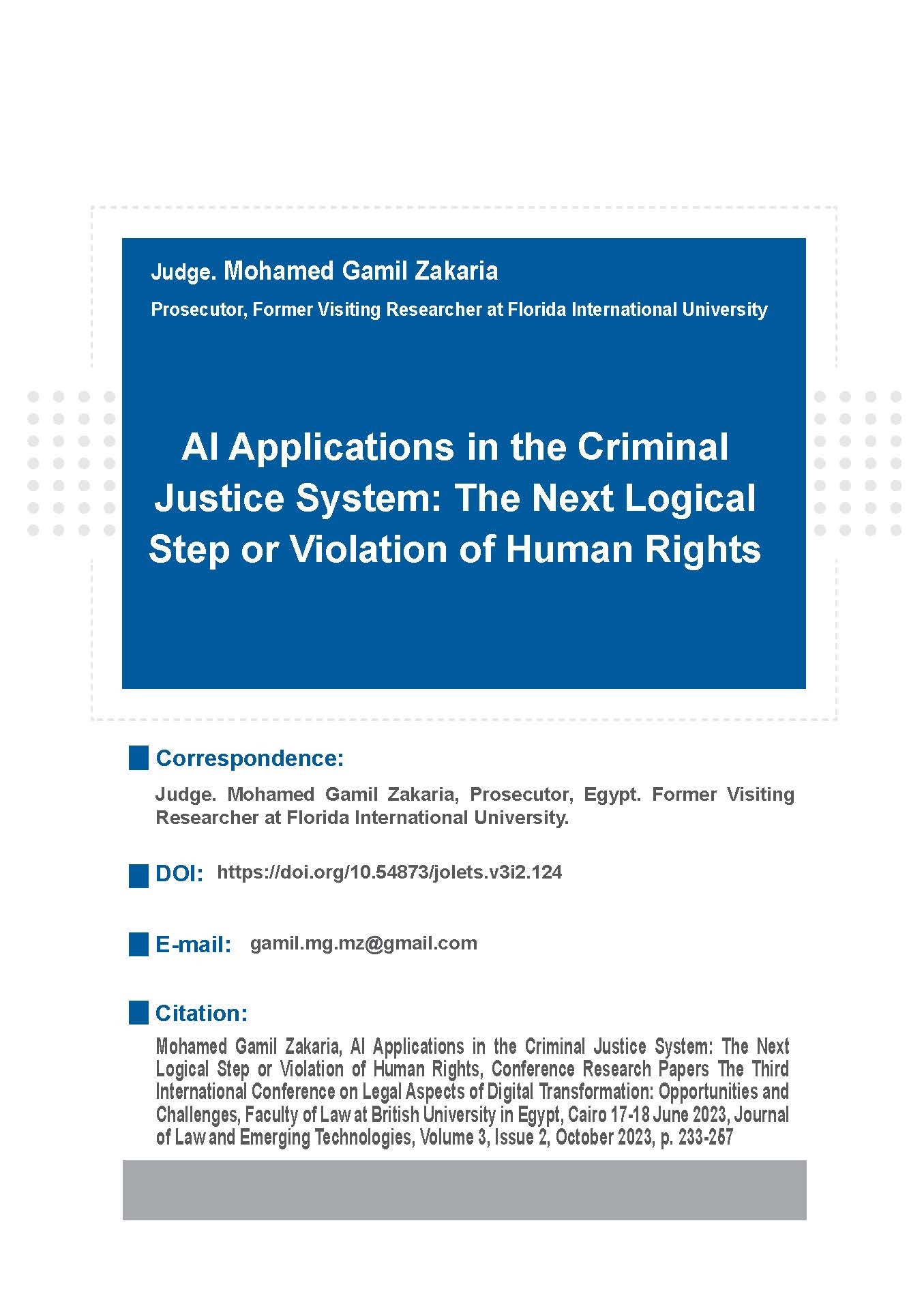AI Applications in the Criminal Justice System: The Next Logical Step or Violation of Human Rights
Corresponding Author(s) : Judge. Mohamed Gamil Zakaria
Journal of Law and Emerging Technologies,
Vol. 3 No. 2 (2023)
Abstract
Artificial intelligence (AI) is impacting almost every aspect of our lives, and automated decisions have begun to replace human decisions. Recently, criminal justice has also turned to AI to reduce crime rates and achieve effective action on the ground. Artificial intelligence and machine learning algorithms (ML) could predict and track crimes and criminals. In addition, they could be used in criminal courts. However, there is ample evidence that the application of this technology has affected basic human rights. In several countries, law enforcement agencies (LEAs), i.e., government agencies responsible for law enforcement, have begun using these technologies despite concerns about the presence of bias in the results and invasion of citizens' privacy. This research paper provides an overview of some AI applications used in criminal justice to predict crimes and offenders, detect and investigate crimes, and assist judges in criminal courts. It also examines the human rights implications of using these applications in this system.
Keywords
Download Citation
Endnote/Zotero/Mendeley (RIS)BibTeX
- Perry, W. L., McInnis, B., Price, C. C., Smith, S., & Hollywood, J. S. (2013). Predictive Policing: The Role of Crime Forecasting in Law Enforcement Operations. DOI: https://doi.org/10.7249/RR233
- Stroud, M. (2021, May 24). An automated policing program got this man shot twice. The Verge. Retrieved February 4, 2022, from https://www.theverge.com/22444020/heat-listed-csk-entry
- Ferguson, A. G. (2016). Policing Predictive Policing.
- Agbo-Ajala, O., & Viriri, S. (2020). Deeply Learned Classifiers for Age and Gender Predictions of Unfiltered Faces. DOI: https://doi.org/10.1155/2020/1289408
- Wu, X., & Zhang, X. (2016). Responses to Critiques on Machine Learning of Criminality Perceptions
- Bowyer, K. W., King, M., Scheirer, W., & Vangara, K. (2020). The Criminality from Face Illusion. DOI: https://doi.org/10.1109/TTS.2020.3032321
- Oswald, M., Grace, J., Urwin, S., & Barnes, G. C. (2018). Algorithmic risk assessment policing models: lessons from the Durham HART model and ‘Experimental’ proportionality. Information & Communications Technology Law DOI: https://doi.org/10.2139/ssrn.3029345
- Danziger, S., Levav, J., & Avnaim-Pesso, L. (2011). Extraneous factors in judicial decisions. DOI: https://doi.org/10.1073/pnas.1018033108
- Tversky, A., & Kahneman, D. (1974). Judgment under Uncertainty: Heuristics and Biases. DOI: https://doi.org/10.21236/AD0767426
- Dymitruk, M. (2019). The Right to a Fair Trial in Automated Civil Proceedings. DOI: https://doi.org/10.5817/MUJLT2019-1-2
- Salem, M., Lakatos, G., Amirabdollahian, F., & Dautenhahn, K. (2015). Would You Trust a (Faulty) Robot? Effects of Error, Task Type and Personality on Human-Robot Cooperation and Trust. DOI: https://doi.org/10.1145/2696454.2696497
References
Perry, W. L., McInnis, B., Price, C. C., Smith, S., & Hollywood, J. S. (2013). Predictive Policing: The Role of Crime Forecasting in Law Enforcement Operations. DOI: https://doi.org/10.7249/RR233
Stroud, M. (2021, May 24). An automated policing program got this man shot twice. The Verge. Retrieved February 4, 2022, from https://www.theverge.com/22444020/heat-listed-csk-entry
Ferguson, A. G. (2016). Policing Predictive Policing.
Agbo-Ajala, O., & Viriri, S. (2020). Deeply Learned Classifiers for Age and Gender Predictions of Unfiltered Faces. DOI: https://doi.org/10.1155/2020/1289408
Wu, X., & Zhang, X. (2016). Responses to Critiques on Machine Learning of Criminality Perceptions
Bowyer, K. W., King, M., Scheirer, W., & Vangara, K. (2020). The Criminality from Face Illusion. DOI: https://doi.org/10.1109/TTS.2020.3032321
Oswald, M., Grace, J., Urwin, S., & Barnes, G. C. (2018). Algorithmic risk assessment policing models: lessons from the Durham HART model and ‘Experimental’ proportionality. Information & Communications Technology Law DOI: https://doi.org/10.2139/ssrn.3029345
Danziger, S., Levav, J., & Avnaim-Pesso, L. (2011). Extraneous factors in judicial decisions. DOI: https://doi.org/10.1073/pnas.1018033108
Tversky, A., & Kahneman, D. (1974). Judgment under Uncertainty: Heuristics and Biases. DOI: https://doi.org/10.21236/AD0767426
Dymitruk, M. (2019). The Right to a Fair Trial in Automated Civil Proceedings. DOI: https://doi.org/10.5817/MUJLT2019-1-2
Salem, M., Lakatos, G., Amirabdollahian, F., & Dautenhahn, K. (2015). Would You Trust a (Faulty) Robot? Effects of Error, Task Type and Personality on Human-Robot Cooperation and Trust. DOI: https://doi.org/10.1145/2696454.2696497




